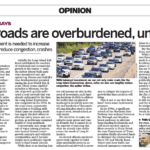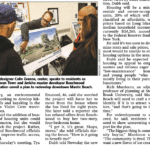Vision Long Island’s Eric Alexander recently argued on LIBN’s pages for a continuation of the smart growth movement’s hyperlocal approach as the be-all, end all solution that works for Long Island. Alexander cites the accomplishments of the movement, chides regionalism, and paints a rosy picture for the future.
However, some issues will always be regional in nature whether we like it or not.
Interestingly enough, in remarks concerning the status of the “smart growth” movement, Alexander touts successes that by their very nature, are regional at their core. Sewers, the MTA’s Double Track and renewable energy policy are all regional issues by definition. They span multiple governmental jurisdictions, and have economic impacts that reach far beyond their supposed local scope. The movement’s goals impact each and every Long Island resident in one way or another through quality of life or cost-of-living. This supposed local movement is beginning to look pretty regional.
These inherent regional issues should NOT be “shaped locally”, for their impacts resonate far beyond the local fiefdoms of Long Island’s villages and towns.
Alexander contradicts himself- the very notion of a smart growth movement, for better or worse, is a regional initiative that is being undertaken and executed locally. Alexander’s model is upside down. The concept in of itself seems to be a regional effort, despite claims otherwise. Alexander touts the Ronkonkoma hub – while currently executed on a local level by TRITEC and the Town of Brookhaven, was first suggested and conceptualized in regional plans predating Vision Long Island’s existence by about forty years.
Without a regional effort to electrify the mainline, the hub wouldn’t have been possible. Alexander cites the sewer expansion for Mastic and Shirley – which was justified by regional studies on Long Island’s aquifer – which shows no respect for the boundaries for villages, towns and counties.
Further- Alexander condemns the cost overruns of MTA’s East Side Access- a critical infrastructure improvement with the aim of increasing ridership on the LIRR. It is projects such as these that justify the existence of “smart growth” – regional, capital improvements allow Alexander’s local friends to justify their TOD and vast density increases. You can’t criticize a project that may very well justify the very “smart growth” developments being celebrated.
Perhaps the supposed “smart growth” movement is engaged in a willful ignorance of their regional roots. The movement has yet to produce a truly nonbiased academic study that justifies its existence on suburban Long Island, beyond seeing the connected pat each other on the back and say job well done at yet another ribbon cutting for an apartment complex. While it seems that some development and local leaders vilify an academic approach to Long Island’s development, in the coming decades it will be interesting to see what will be done when the aquifer system is tainted beyond repair, or when Long Island’s aging parkway and expressway network cannot handle all of the impacts brought about by the “smart growth” being placed around Nassau and Suffolk Counties.
Will the localities clean up Long Island’s aquifer, fix the aging railroad tunnels and tracks, and expand capacity on our road network? Can Vision Long Island’s hyperlocal approach handle the burden of cost when it comes time to bridge the freight rail gap from Long Island to New Jersey, or can they further improve capacity along the LIRR through electrification?
When one so easily dismisses regionalism, they are truly thinking small.










